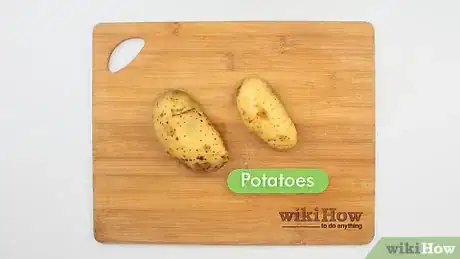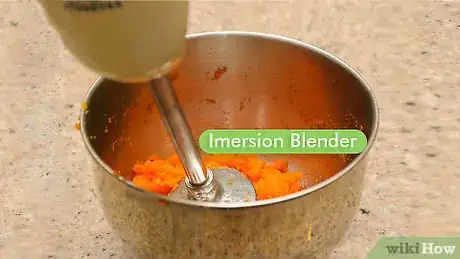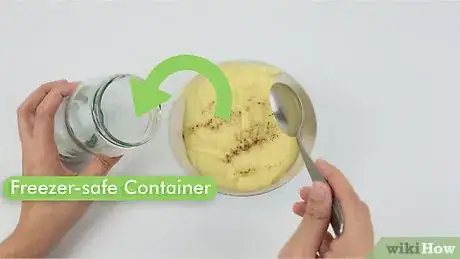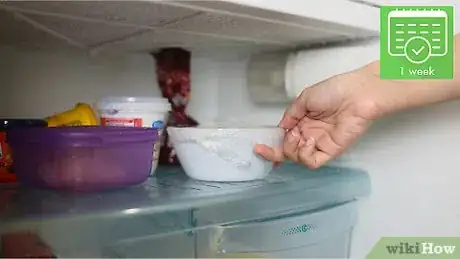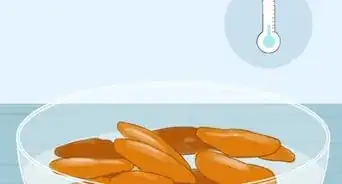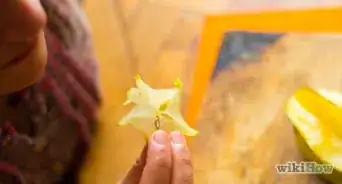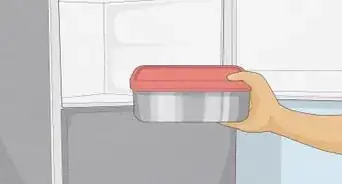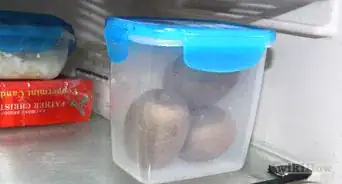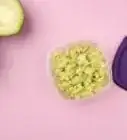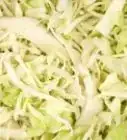This article was co-authored by wikiHow Staff. Our trained team of editors and researchers validate articles for accuracy and comprehensiveness. wikiHow's Content Management Team carefully monitors the work from our editorial staff to ensure that each article is backed by trusted research and meets our high quality standards.
There are 12 references cited in this article, which can be found at the bottom of the page.
The wikiHow Video Team also followed the article's instructions and verified that they work.
This article has been viewed 105,548 times.
Learn more...
Puréed vegetables form the basis for many delicious soups, such as butternut squash soup. They can also be a nutrient-rich base for pasta sauces. Puréed vegetables are also a staple for parents who want to make their own baby food. To make a smooth, silky purée, it's essential to cook the vegetables well before processing.
Steps
Choosing and Prepping Vegetables
-
1Choose fresh, ripe vegetables. The most flavorful and nutritious purées are made with the freshest vegetables that are at the peak of ripeness. Choose vegetables with firm flesh and bright color. Avoid vegetables with bruising or soft spots.[1]
- While frozen or canned vegetables can be used to create purées, they won't have the same nutritional value and flavor as purees made with fresh vegetables.
- Any type of vegetable can be puréed (though it's harder to get a smooth purée with stringy greens). Try carrots, sweet potatoes, white potatoes, green beans, broccoli squash, and any other vegetable with flesh that becomes soft when cooked.
-
2Wash the vegetables. Make sure to rinse away all traces of dirt by running the vegetables under a stream of cold water.[2] You may want to use a vegetable cleanser if you're using vegetables that were treated with pesticides.[3]Advertisement
-
3Peel the vegetables if necessary. Cut both the top and bottom ends off of your vegetables with a knife, and remove any places with bruising. Use a paring knife or a vegetable peeler to remove tough peels from sweet potatoes, white potatoes, carrots, squash, and other vegetables with peels.[4]
-
4Cut the vegetables into thin slices. Cutting the vegetables into slices instead of chunks will mean less cooking time, and your purée will come out smoother.[5]
Cooking the Vegetables
-
1Boil a few inches of water in a large saucepan.[6] There's no need to fill it up; you just need a few inches of water to steam the vegetables. Two to four cups of water will be sufficient, depending on the size of the pan you're using.
- Steaming vegetables is the best way to preserve their nutrient content. Boiling vegetables is another option for softening them, but boiling has been found to destroy some of the nutrients.[7]
-
2Steam the vegetables for 15 to 20 minutes. Fill the steamer basket with your vegetable slices and put the basket inside the saucepan. Cover the saucepan to begin steaming your vegetables. Avoid crowding the steamer basket with too many vegetables; you may have to do it in batches. After 15 to 20 minutes, the vegetables should be completely soft.[8]
- If you don't have a steamer basket, place the vegetable slices into the boiling water. Boil them for 15 minutes or until they feel tender when pierced with a fork. Be careful not to crowd the pan.
-
3Transfer the cooked vegetables to a large bowl. Remove the vegetables from the steamer basket or saucepan using a slotted spoon or a stainless steel mesh strainer and place them in a bowl. Continue steaming batches of vegetables until all of your vegetables are softened and ready to puree.
Puréeing the Vegetables
-
1Use a food processor or blender. Scoop approximately 1 cup of cooked vegetables from the bowl and place them inside the blender or food processor. Purée the vegetables in batches, adding a little water as necessary to achieve a smooth texture.[9]
- For best results, try not to purée more than 1 cup of softened vegetables at a time.
- Scrape the purée out of your food processor or blender and put it into a separate container. Store the purée for later use or use it in a recipe according to the instructions.
-
2Try a food mill. A food mill is a large metal perforated bowl fitted with a blade. As you crank the handle, the softened vegetables are smashed and pushed through a strainer and come out in pureed form.You don’t have to peel the vegetables for this method since the food mill will naturally separate the flesh from the skin. You’ll have a chance later on in the process to discard the skins and seeds.[10]
- Place a large bowl on your countertop. You will need this bowl to catch the puree as it comes out of the food mill.
- Place 1 cup of softened vegetables into the mill.
- Turn the handle in a clockwise direction with your dominant hand as you hold onto the contraption with your non-dominant hand. The puréed vegetable flesh will be pushed through the strainer into your bowl.
-
3Use an immersion blender with a little water. An immersion blender, or hand-held blender, can be used to purée the vegetables right in the bowl or the pot you cooked them in if you add a little water. Place the immersion blender into your bowl of vegetables so that the blade is about 1” beneath the top layer of vegetables. Turn the blender on and guide the blender through the vegetable pieces in a circular motion. Continue blending until all of the pieces are puréed.[11]
- If you raise the blade above the level of the vegetables, then the blade will spatter vegetable pieces and make a mess. Turn the blender off while it is still beneath the surface of the purée to prevent spattering.
- When the blade has stopped spinning, lift it out of the purée and set it aside.
Using and Storing the Purée
-
1Season the purée if desired. If the purée is to be used as baby food, you may not want to add seasonings. For kids and adults, however, vegetable purées taste delicious with seasonings. Try a pinch of salt and pepper and a pat of butter or a few spoonfuls of cream. This will enrich the flavor of the vegetables and help create a smoother texture.
-
2Refrigerate vegetable purée for up to a week. Spoon the purée into airtight containers (such as sterilized glass jars) and store in the refrigerator until use, for up to a week. You may want to label the jars with the type of food and date.[12]
-
3Freeze vegetable purée for several months. Spoon the purée into freezer-safe containers, making sure to remove as much air as possible. Freeze the purée for several months. You may want to label the jars with the type of food and date.[13]
-
4Finished.
Community Q&A
-
QuestionHow do I make puree vegetables for people with swallowing problems?
 Community AnswerBoil the vegetables until they're soft. You can use a blender on the pulse setting to puree. If you do not have a blender, you can use a fork to mash the vegetables into a paste that should be easy for swallowing.
Community AnswerBoil the vegetables until they're soft. You can use a blender on the pulse setting to puree. If you do not have a blender, you can use a fork to mash the vegetables into a paste that should be easy for swallowing. -
QuestionWhat are some recipes for pureed vegetables?
 Community AnswerBeetroot Puree, Potato Carrot Sweet Corn Puree, Spinach Puree, Carrot Palak Puree, Broccoli Potato Cheese Puree and Lentil Spinach and Rice Puree.
Community AnswerBeetroot Puree, Potato Carrot Sweet Corn Puree, Spinach Puree, Carrot Palak Puree, Broccoli Potato Cheese Puree and Lentil Spinach and Rice Puree.
Warnings
- Hot vegetables let off a great deal of steam when blended in a blender. If you are using a blender to puree your vegetables, be sure to let them cool slightly. The pressure from the steam could pop off the top of your blender.⧼thumbs_response⧽
- When preparing vegetable purées for baby food, use organic vegetables grown without pesticides whenever possible. Also, keep your hands and your cooking environment as clean as possible to avoid foodborne illness.[14]⧼thumbs_response⧽
Things You'll Need
- Vegetables for puréeing
- Large saucepan or Dutch oven
- Cutting board
- Paring knife
- Vegetable peeler
- Steamer basket, if desired
- 2 large bowls (1 for the vegetables after you soften them, and 1 for the vegetables after you puree them)
- Blender or food processor
- Food mill
- Immersion blender
References
- ↑ https://www.thekitchn.com/how-to-select-the-best-produce-1-108350
- ↑ https://www.fda.gov/consumers/consumer-updates/7-tips-cleaning-fruits-vegetables
- ↑ https://www.epicurious.com/expert-advice/fruit-vegetable-wash-scientific-tests-article
- ↑ http://wholesomebabyfood.momtastic.com/VegetableRecipes.htm#.VIothWTF8m9
- ↑ https://www.youtube.com/watch?v=Ydc_SaQ_eRQ
- ↑ https://www.youtube.com/watch?v=kieGBkOdyMU
- ↑ https://www.finecooking.com/article/the-right-way-to-cook-vegetables
- ↑ https://www.epicurious.com/expert-advice/how-to-steam-vegetables-step-by-step-article
- ↑ http://www.parents.com/recipes/baby-food/how-to-make-carrot-puree/
- ↑ https://www.seriouseats.com/2010/07/how-to-make-a-vegetable-puree.html
- ↑ https://www.seriouseats.com/2010/07/how-to-make-a-vegetable-puree.html
- ↑ https://www.foodsafety.gov/people-at-risk/children-under-five
- ↑ https://www.foodsafety.gov/people-at-risk/children-under-five
- ↑ https://www.fsis.usda.gov/wps/portal/fsis/topics/food-safety-education/get-answers/food-safety-fact-sheets/safe-food-handling/cleanliness-helps-prevent-foodborne-illness/ct_index
About This Article
To puree vegetables, start by cleaning them well to get rid of any traces of dirt or pesticide and removing any tough peels with a vegetable peeler. Then, cut the vegetables into thin slices so they’ll cook faster. Next, boil a few inches of water in a saucepan and add in the vegetables. Once they’ve cooked for 20 minutes, remove them from the water and transfer the vegetables to the bowl of a food processor or blender. Finally, blend the vegetables until they’re smooth and season the puree with salt and pepper. To learn how to freeze vegetable puree to use later, read on!
